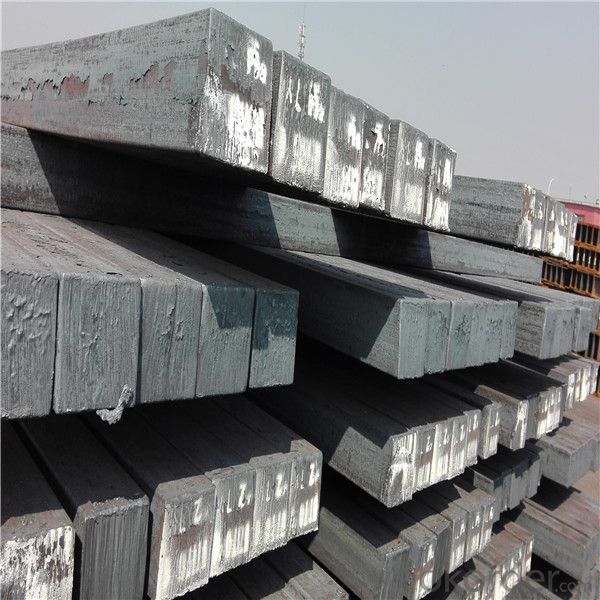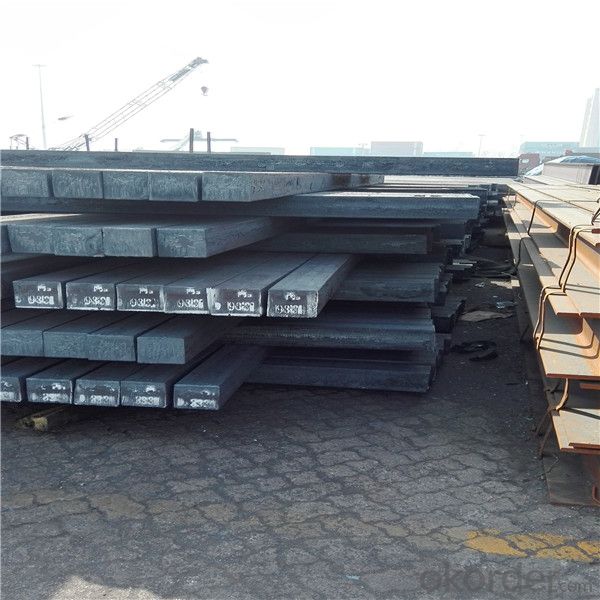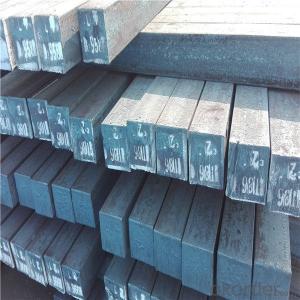Hot rolled square steel billet prime steel
- Loading Port:
- Tianjin
- Payment Terms:
- TT OR LC
- Min Order Qty:
- 1000 m.t.
- Supply Capability:
- 29437 m.t./month
OKorder Service Pledge
OKorder Financial Service
You Might Also Like
Item specifice
Steel billet(ingot) by cogging or breakdown of semi-finished products, is the raw material of all kinds of steel mill. Billet section of square, round, flat, rectangular
and abnormity of several kinds of, mainly related to the shape of rolled products.
Rectangular billet continuous casting billet and mainly general carbon steel, low carbon low silicon cold-rolled material, high quality carbon structural steel, high strength low alloy steel, special steel, etc.
The billet is mainly divided into two kinds from the shape:
Slab: cross section width and height of the ratio of the larger, mainly used for rolling plate.
Size :100mm to 165mm
Length:6~12meters
Grade: Q195/Q215/Q235/Q275
Qaulity:own factory, stable quality
Tolerance: Strictly according to the G/B and JIS standard
Gade:
Standard | C(%) | Mn(%) | S(%) | P(%) | Si(%) |
Q195 | ≤0.12 | ≤0.50 | ≤0.040 | ≤0.035 | ≤0.30 |
Q235 | ≤0.20 | ≤1.40 | ≤0.045 | ≤0.045 | ≤0.35 |
Q275 | ≤0.22 | ≤1.50 | ≤0.045 | ≤0.045 | ≤0.35 |
20MnSi | 0.17-0.25 | 1.2-1.6 | ≤ 0.050 | ≤ 0.050 | 0.40-0.80 |
3SP | 0.14-0.22 | 0.40-0.85 | ≤ 0.050 | ≤ 0.040 | 0.05-0.15 |
5SP | 0.28-0.37 | 0.50-1.00 | ≤ 0.050 | ≤ 0.040 | 0.15-0.30 |



Our service :
We have a plant and professional team to provide our best service, from the start of production until the
loading into the vessel, we have a complete quality follow up procedure, to assure our products arrives to the customer with satisfaction. Welcome new and old customers
to contact us for future business relationships! We will give you a surpise price.
Packing :
Within 30 days
1.Standard export package
2.In bundles with steel strips
3.As the requirements of the customers
FAQ:
Q: What is payment terms?
A: FOB 30% T/T IN ADVANCE AS DEPOSIT AND 70% T/T BEFORE SHIPMENT
CIF and CFR 30% T/T IN ADVANCE AS DEPOSIT AND 70% T/T AS THE COPY OF B/L OR L/C AT SIGHT
Q:How to guarantee the quality of the products?
A:We have established the international advanced quality management system,every link from raw material
to final product we have strict quality test;We resolutely put an end to unqualified products flowing into the market.
At the same time, we will provide necessary follow-up service assurance.
Q:How long can we receive the product after purchase?
A :In the purchase of product within three working days, We will arrange the factory delivery as soon as possible.
The pecific time of receiving is related to the state and position of customers.
- Q:How are steel billets used in the production of pressure vessels?
- Due to their remarkable strength and durability, steel billets are commonly utilized in the production of pressure vessels. Pressure vessels, such as tanks or containers, are specifically designed to store or transport fluids or gases under high pressures. To manufacture pressure vessels, the initial step involves heating steel billets and subjecting them to a process known as hot rolling. This process entails passing the billets through a series of rollers in order to shape them into the desired form. The hot rolling process not only imparts the final shape to the billets but also enhances their mechanical properties, thereby making them more suitable for withstanding high pressures. Following the hot rolling process, the billets undergo further processing using a variety of techniques, including forging, machining, and welding. These techniques are employed to create the necessary components of the pressure vessel, such as the shell, heads, nozzles, and other fittings. The preference for steel billets in pressure vessel production stems from their high tensile strength and resistance to deformation. This ensures that the vessel can endure the internal pressure without experiencing any structural failure. Additionally, steel billets are capable of withstanding a wide range of temperatures, rendering them suitable for diverse applications involving pressure vessels. In addition to their mechanical properties, steel billets also possess exceptional corrosion resistance. This quality is crucial for pressure vessels, as they often come into contact with corrosive substances or environments. By utilizing corrosion-resistant steel billets, the lifespan of the pressure vessel is extended, thereby reducing the frequency of maintenance and replacement. In conclusion, the utilization of steel billets is of utmost importance in the production of pressure vessels, as they provide the necessary strength, durability, and corrosion resistance required for the safe storage or transportation of fluids or gases under high pressures.
- Q:How are steel billets used in the manufacturing of oil and gas components?
- Steel billets play a crucial role in the manufacturing process of oil and gas components. These billets serve as essential materials and are created through a process known as casting. In this process, molten steel is poured into a mold and allowed to solidify into a rectangular shape, resulting in semi-finished products. Once formed, steel billets are utilized in various ways to produce components for the oil and gas industry. One common application involves their use in the production of pipes, which are vital for transporting oil and gas from reservoirs to processing facilities or end-users. Depending on project requirements, steel billets can be further processed to create seamless or welded pipes. Aside from pipes, steel billets are also employed in the manufacturing of other important oil and gas components such as valves, fittings, flanges, and pressure vessels. These components are crucial for ensuring the safe and efficient operation of oil and gas facilities, as they facilitate proper flow control, connection, and containment of fluids under high pressures and temperatures. The utilization of steel billets in the manufacturing process of oil and gas components offers several advantages. Firstly, steel is widely recognized for its strength, durability, and resistance to corrosion, making it highly suitable for the harsh and demanding operating conditions of the industry. Additionally, steel billets allow for flexibility in terms of size, shape, and composition, enabling manufacturers to produce components tailored to meet specific project requirements. In conclusion, steel billets play a critical role in the production of oil and gas components. They provide the necessary strength, durability, and versatility required for the safe and efficient operation of the industry.
- Q:How are steel billets labeled for identification purposes?
- To identify steel billets, a combination of alphanumeric codes and markings are utilized. These labels contain vital data regarding the billet's composition, size, and other significant particulars. The most prevalent approach to label steel billets involves directly stamping or engraving the necessary information onto the billet's surface. This includes details like steel grade, heat number, lot number, and the manufacturer's symbol or logo. These markings are typically made using durable and legible industrial-grade ink or via electrochemical etching, ensuring their resilience even in harsh environments. Additionally, steel billets may also carry identification tags or labels that offer additional information which cannot be easily engraved or stamped. These tags or labels may feature barcodes, QR codes, or RFID tags, allowing for quick access to relevant information through specialized equipment. By employing these labeling methods, steel billets can be easily identified, tracked, and monitored throughout their lifespan. This ensures effective quality control, inventory management, and efficient production processes within the steel industry.
- Q:What is the role of steel billets in the production of valves and fittings?
- Steel billets play a crucial role in the production of valves and fittings as they serve as the primary raw material for manufacturing these products. The billets are heated and then shaped and formed through various processes like forging, machining, and welding to create the desired valve or fitting. The high strength and durability of steel billets ensure the reliability and longevity of valves and fittings, making them essential components in industries such as oil and gas, water treatment, and manufacturing.
- Q:How are steel billets used in the manufacturing of pressure vessel components?
- Steel billets are used in the manufacturing of pressure vessel components by being melted and formed into the desired shape through processes like casting, forging, or extrusion. These billets serve as the raw material for creating various components such as shells, heads, and nozzles, which are then further processed, machined, and assembled to construct the pressure vessel.
- Q:How do steel billets contribute to the overall aesthetics of a product?
- The overall aesthetics of a product can be greatly enhanced by steel billets in various ways. Firstly, the appearance of the final product is greatly influenced by the quality and finish of steel billets. Steel billets are commonly used as raw materials in manufacturing processes like forging, rolling, or machining. The sleek and refined look of the end product is achieved by using high-quality steel billets with smooth surfaces and uniform shapes. Furthermore, steel billets offer designers and manufacturers a wide range of possibilities in terms of shape and size. They can be easily customized and transformed into different forms, allowing for intricate and unique designs that enhance the visual appeal of the product. Steel billets can be molded, cut, or manipulated to create complex patterns, textures, or contours, providing endless opportunities for artistic expression. Additionally, the strength and durability of steel billets contribute to the longevity and resilience of the final product. Aesthetics are not solely based on visual appeal but also on the perception of quality. Steel billets, known for their robustness and resistance to corrosion, instill a sense of reliability and sturdiness. This perceived quality enhances the overall attractiveness of the product, making it more appealing to consumers. In conclusion, steel billets play a significant role in enhancing the overall aesthetics of a product by providing a high-quality, customizable, and durable raw material. Their smooth surface, versatility in shaping, and inherent strength enhance the visual appeal, enabling designers to create visually captivating and long-lasting products.
- Q:What are the common sizes of steel billets?
- The common sizes of steel billets can vary depending on the specific industry and application. However, there are several standard sizes that are commonly used. In the construction industry, the most common sizes of steel billets range from 100mm x 100mm to 200mm x 200mm. These sizes are often used for structural steel fabrication, such as beams, columns, and other load-bearing components. For the manufacturing of automotive parts, the common sizes of steel billets typically range from 150mm x 150mm to 250mm x 250mm. These sizes are commonly used for forging and machining processes to create components like crankshafts, connecting rods, and gears. In the oil and gas industry, larger steel billets are often required for the production of pipes and tubes. The common sizes for this application range from 350mm x 350mm to 500mm x 500mm. These larger billets allow for the production of seamless pipes that can withstand high-pressure environments. It's important to note that these are just general sizes and can vary depending on specific project requirements and regional standards. Additionally, custom sizes can also be produced based on the customer's needs.
- Q:What are the different types of steel billet rolling mill automation systems?
- There are various types of steel billet rolling mill automation systems, including manual systems where operators control the process manually, semi-automatic systems where certain steps are automated but still require operator intervention, and fully automatic systems where the entire process is controlled by computerized systems with minimal human intervention.
- Q:What are the potential applications of steel billets in the oil and gas industry?
- The oil and gas industry can utilize steel billets in a wide range of ways. These include, but are not limited to, the following: 1. Manufacturing pipes: Steel billets can be used to create pipes that are crucial for transporting oil and gas. The strength and durability of steel make it an excellent choice for constructing pipes that can withstand the harsh conditions of drilling, extraction, and transportation. 2. Creating drill collars: Steel billets can be machined into drill collars, which are heavy steel tubes used in drilling. Drill collars provide weight to the drill string, increasing the force applied to the drill bit. The strength and toughness of steel billets make them suitable for this application, as they can withstand the high torque and pressure exerted during drilling. 3. Making downhole tools: Steel billets can also be used to manufacture a variety of downhole tools used in oil and gas exploration, including stabilizers, reamers, and subs. These tools are crucial for maintaining wellbore stability, clearing obstructions, and enhancing drilling efficiency. The ability of steel billets to withstand high temperatures, pressures, and abrasive environments makes them suitable for these tools. 4. Constructing offshore structures: Steel billets can be used in the construction of offshore platforms, jackets, and other structural components. These structures must withstand extreme weather conditions, corrosive environments, and heavy loads. Steel billets, with their high strength, corrosion resistance, and weldability, are an ideal choice for such applications. 5. Machining equipment and machinery components: Steel billets can be machined into various components and parts for oil and gas equipment and machinery. This includes valves, fittings, flanges, connectors, and other critical components used in drilling rigs, pipelines, refineries, and processing facilities. The versatility and reliability of steel make it a preferred material for such applications. In summary, steel billets have a wide range of potential applications in the oil and gas industry. Their high strength, durability, corrosion resistance, and versatility make them essential in pipe manufacturing, the creation of drill collars and downhole tools, the construction of offshore structures, and the machining of equipment components. Steel billets play a crucial role in ensuring the efficiency, safety, and reliability of oil and gas operations.
- Q:Can steel billets be used for making cutlery?
- Steel billets have the potential to be utilized in the creation of cutlery. These billets serve as the primary substance in the manufacturing of a variety of steel commodities, which encompass cutlery. Once heated, the billets are then transformed into desired forms, such as knives, forks, or spoons, through methods like forging or casting. The resultant steel cutlery possesses notable attributes such as strength, durability, and the ability to maintain a sharp edge. Nevertheless, it is important to recognize that the specific kind of steel employed and the manufacturing procedures substantially influence the quality and characteristics of the cutlery.
1. Manufacturer Overview |
|
|---|---|
| Location | |
| Year Established | |
| Annual Output Value | |
| Main Markets | |
| Company Certifications | |
2. Manufacturer Certificates |
|
|---|---|
| a) Certification Name | |
| Range | |
| Reference | |
| Validity Period | |
3. Manufacturer Capability |
|
|---|---|
| a)Trade Capacity | |
| Nearest Port | |
| Export Percentage | |
| No.of Employees in Trade Department | |
| Language Spoken: | |
| b)Factory Information | |
| Factory Size: | |
| No. of Production Lines | |
| Contract Manufacturing | |
| Product Price Range | |
Send your message to us
Hot rolled square steel billet prime steel
- Loading Port:
- Tianjin
- Payment Terms:
- TT OR LC
- Min Order Qty:
- 1000 m.t.
- Supply Capability:
- 29437 m.t./month
OKorder Service Pledge
OKorder Financial Service
Similar products
New products
Hot products
Related keywords





























